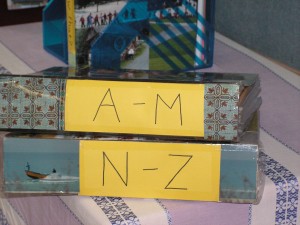
(I took this one!)
The basic idea of flipped classrooms is that the student is presented with information needed outside the classroom (by using tools such as videos), so that the time spent in class with the teacher will be utilized in a meaningful and most beneficial manner.
I’ve heard about this many times before. But the article “Flipping for Mastery” by Bergmann & Sams in the January 2014 issue of EL Magazine brings the idea of flipped classrooms right into the reality of my classroom, by acknowledging the diversity in class and the need for different students to get different materials. “In this model, students work through course content at a flexible pace, receiving direct instruction asynchronously when they are ready for it. When they get to the end of the unit, they must demonstrate mastery of the learning objective before they move on” (page 25).
I’ve been teaching in the format of a learning center for years, with different students doing wildly different things. Although my students need a lot of mediation (they often don’t read instructions or understand them correctly, they have trouble with unfamiliar concepts in reading comprehension texts, etc.), spending some time with some students and then others (and then back again) worked well most of the time.
Since we began the new literature program (we study 3 stories and 3 poems, authentic ones, not written for learners!) the level of mediation needed by my students has risen dramatically. In the beginning of the year I may have started off with a fairly large number of students studying the same story, but in no time at all the students are at different stages of it. Some are brighter and more industrious than others. Some simply missed more lessons or have “bad days”. The kind when I feel as if only their bodies arrived in class.
Yet everyone has to progress until they master the piece.
I need “flipped mastery” IN class. I feel I need more tools to mediate the literature pieces that the students can acces when working in class, so that they don’t all need my help at the same time.
But this isn’t chemistry, the topic taught by the writers of this fascinating article. I haven’t find the golden balance between materials that clarify what needs explaining without it bypassing English altogether.
For example, here’s something I’ve been struggling for several weeks now (before reading the article!).
Here Mrs.Tammy Assouline visualizes a difficult sentence for some of our Deaf students. The sentence is from “The Treasure of Lemon Brown” by Walter Dean Myers.
The sentence is:
“Greg opened his mouth to quiet the sound of his breath as he sucked it in uneasily.”Many students didn’t really understand the sentence as they didn’t think that someone could hear the sound of their breathing.
On one hand, this 10 second video would appear to be a good idea. Instead of my explaining it as each student reached the sentence, perhaps the students could have a page with QR codes (which would lead to the video) to refer to when reaching this sentence, and others like it. I could have such videos for the instructions and the complex questions too, which I spend so much time on explaining.
On the other hand, I’m afraid to open a can of worms! The students must learn to read instructions. They must try to understand the difficult question or sentences before I explain them. Some of them succeed! They won’t try when the help sheet is in front of them!
In addition, such a video is difficult to break down and connect to vocabulary items in English. Which wouldn’t matter much if I just limit it to sentences which would be particularly difficult for a deaf student to understand, like the fact that a person’s breathing could give away his location.
So, how to approach creating my mediating materials? I don’t know!
B.T.W – Very helpful tips on how to easily create multiple versions of mastery tests, since students take these tests on different dates.



